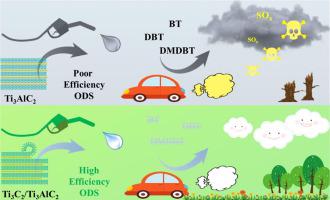Chemical Engineering Journal ( IF 13.3 ) Pub Date : 2021-10-14 , DOI: 10.1016/j.cej.2021.132950 Qingxiao Zhang 1 , Jing He 2 , Xueli Fu 1 , Songhai Xie 3 , Runze Fan 1 , Huirong Lai 1 , Weihua Cheng 1 , Peiyi Ji 1 , Jie Sheng 1 , Qingliang Liao 1 , Wenshuai Zhu 2 , Hui Li 1

|
Hydrofluoric acid is inevitable in most preparation schemes for two-dimensional MXene materials, which is dangerous and environmentally hazardous. Herein, hydroxylated Ti3C2/Ti3AlC2 (h-TC/TAC) catalysts were prepared via an alkaline etching process using a safer, more environmentally friendly alkali. After preferentially forming a hydroxylated Ti3C2 MXene layer on the surface of Ti3AlC2, Ti-C bonds on the surface were partially hydrolyzed, which exposed more active sites. Alkaline etching modulated the chemical composition and electronic structure of the catalyst surface, thus concentrating the active sites on the surface, which improved the activation efficiency and substrate conversion. For the aerobic oxidative desulfurization of a model fuel with a sulfur content of 220 ppm, the prepared catalyst exhibited a desulfurization rate of up to 99% when using air as a cheap molecular oxygen source. The enhanced activity of the h-TC/TAC catalyst was attributed to the continuous activation of molecular oxygen to form •OH and •O2–. Moreover, because the main structure of Ti3AlC2 was maintained, the catalyst could be recycled 8 times without a significant decrease in activity. This work not only shows the potential of alkaline etching for preparing MXene materials but also provides an important example of the thermocatalytic application of MXene and MAX phase materials.
中文翻译:

羟基化Ti3C2/Ti3AlC2催化剂的无氟增强好氧氧化脱硫策略及机理
氢氟酸在二维MXene材料的大多数制备方案中是不可避免的,它具有危险性和环境危害性。在此,羟基化的 Ti 3 C 2 /Ti 3 AlC 2 (h-TC/TAC) 催化剂是通过使用更安全、更环保的碱的碱性蚀刻工艺制备的。在Ti 3 AlC 2表面优先形成羟基化Ti 3 C 2 MXene层后, 表面的 Ti-C 键部分水解,暴露出更多的活性位点。碱蚀刻调节了催化剂表面的化学成分和电子结构,从而使表面活性位点集中,提高了活化效率和底物转化率。对于硫含量为220 ppm的模型燃料的好氧氧化脱硫,当使用空气作为廉价的分子氧源时,所制备的催化剂表现出高达99%的脱硫率。h-TC/TAC 催化剂的活性增强归因于分子氧的连续活化形成•OH 和•O 2 –。而且,由于 Ti 3 AlC 2的主要结构保持,催化剂可以循环使用 8 次,活性没有显着下降。这项工作不仅展示了碱性蚀刻制备 MXene 材料的潜力,而且为 MXene 和 MAX 相材料的热催化应用提供了一个重要的例子。











































 京公网安备 11010802027423号
京公网安备 11010802027423号